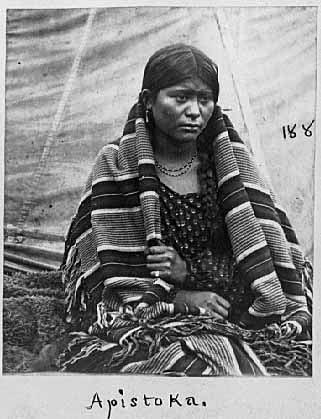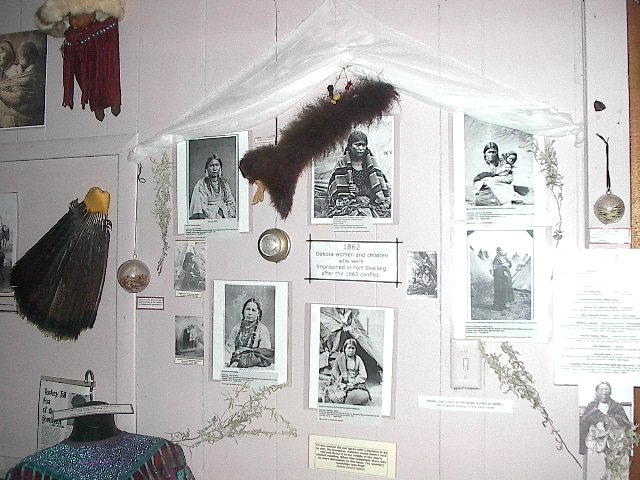Minnesota Dakota Women in 1862
On November 7, 1862, a group of Dakota, primarily women, children and elders, were force-marched in a four-mile long procession from the Lower Sioux Agency to Fort Snelling. Many of them did not survive. In 1862 a six week war broke out in Minnesota between the Dakota and the settlers/US army. It began in August and ended in October, leaving many from both sides dead or injured. Both sides lost in this war, there were no winners, yet the effects of it trickled down the generations......... Today a group of very special women remember their women ancestors, by working on a commemmorative march and following in the footsteps of their great, great, great grandmothers who were forced marched from the Morton area to Fort Snelling. They were joined by the elderly and children, many did not reach Fort Snelling. Since 2003 a number of Dakota women assisted by a few Dakota men and non-native men and women have worked to make this commemmorative march into an event that would draw interest in their ancestors plight and suffering. The Dakota women experienced many horrors during a short period of time. Imagine if you will. you are living peacefully among a group of newcomers to your land, most of them were friendly towards you but some were racist, and wanted only to see you and your people removed from your homelands. You had already lost much when your hunting grounds diminished and game was hard to find, but the government said they would feed you, they would supply you and your people with implements to be able to farm, and they would train you and those who wanted to learn the ways that they said would be the future. The missionaries Riggs and Williamson told you and the people that your ways of prayer were not good enough, they encouraged you all to become Christians, they had even transcribed their 'Bible' into Dakota for you to read, maybe they didn't realize that you couldn't read, and your people told their stories verbally with nothing written down. But anyway they had a lot of the people converted to their Christianity, and many of the people had married in the white way in the church, wearing the wedding rings to show the joining to each other. So there you were, a Native woman, married in a way that was alien to you, living on a small plot of land that had been given to you from the government, learning new ways, but never forgetting who you were and where you came from. Many of your people went to the schools that were offered close by, and things worked fine..... for a while. A couple of years in a row the crops were eaten by grass-hoppers, and so there was no corn for food, but true to their word the government sent your allotment of money when it was supposed to be there and the traders were only too pleased to accept that money from you, however it didn't seem to buy much, and then the traders offered credit to you and your people which seemed really good of them, or so you thought..... Soon when the money arrived it went to the traders for the credit that they said you had used since the last payment..... Then one day the payment didn't arrive, and there was no food, and again the crops had failed and no hunting was allowed. No-one knew why the money didn't come but word had it that the government were too busy fighting their war to care about the poor starving Indians in Minnesota. They asked for more credit from the traders, only to be told that they would have to pay cash or they would not be able to have any more food. One trader told them 'to eat grass or your own dung'. The people were amazed that these people who had willingly taken their money would not help them now that they were in a dire situation. Some of the people were lucky because they had white friends who gave them food and helped but they too were not able to help in the way they wanted to as they had only so much to feed their own families. Before long the dire situation turned to tragedy and people started to die, your friends were starving your family were starving, you were starving, and then something catestrophic happened..... War had been spoken about but the chiefs had stalled it, they didn't want to kill, they told the people that things would get better, they just had to hold on a bit longer and wait...... One morning some young men came to the Chief, Little Crow and told him that they had stolen some eggs from a settler's farm, and what was even worse they had killed the farmer and some other people there including women. They knew that this would cause big trouble. Chiefs spoke to chiefs, taunts were made one to the other and suddenly before you knew it there was war. The people, your people attacked the traders stores, they killed many of them, and to one of them they stuffed his mouth with grass. They took supplies from the stores and and then continued to go to the settlers homes and steal from them. In many cases they allowed the people to leave, especially those who had been good to them, but sadly some also died. Your own husband joined with the bands who were going out to find food, and you never saw him again. This went on for weeks, and suddenly you were rounded up with those others who had stayed close to the area, the men were taken to a place where they were judged to be guilty of horrendous actions towards the white settlers, although they had no chance to speak up for themselves, the translators spoke for them although they didn't always speak the words that were told to them. Your men were asked if they had taken part in the battles, they of course said yes, because to say otherwise would have made them into a coward, even if they had not taken part in any of the actions. They didn't really understand that to kill in this way was not looked at as brave through white eyes. Due to this and other misunderstandings 307 of the men were condemned to hang in Mankato. The women, you included, the elders, the children and a few men were to march to Fort Snelling concentration camp many miles from where your home was, you were to take nothing with you. On November 7th 1862 the forced march began for a group of about 1,700 Dakota, the procession stretched for 4 miles, every day it got harder. Some were attacked by settlers living along the route, some were sick and all were malnourished, and so you watched as your friends and even worse your children died on the way. Two days after the women started their march, after being tried and convicted, over 300 condemned men who were awaiting news of their execution were placed in wagons while they were shackled and then transported to a concentration camp in Mankato, Minnesota. As both groups were paraded through Minnesota towns on their way to the camps, white citizens of Minnesota lined the streets to taunt and assault the defenseless Dakota. Poignant and painful oral historical accounts detail the abuses suffered by Dakota people on these journeys. In addition to suffering cold, hunger, and sickness, the Dakota also endured having rotten food, rocks, sticks and even boiling water thrown at them. An unknown number of men, women and children died along the way from beatings and other assaults perpetrated by both soldiery and citizens. Dakota people of today still do not know what became of their bodies. When you arrived at the concentration camp you were housed in tipis that were made from scraps of material, firewood was scarce, as was food. You endured a whole winter in the freezing Minnesota weather, hundreds died through cold, starvation or sickness, including heart sickness. The women were located away from their men they didn't know if they were alive or dead, they were called savages and heathens, even though many of them were Christian. Can you imagine the pain they went through? Those who survived that atrocious winter were herded onto a boat in the spring and taken to a desolate area in South Dakota called Crow Creek. Again some died on the journey along the Missouri river and again when they arrived more deaths ocurred.
Did your imagination give up during that narrative? It is beyond imagination what these women put up with, but it is so good that their descendents are keeping their memory alive today. In
2003 I was very honoured to have been asked to design and implement
their web site for them. You can see it and read more about these
brave people here,
The display of some of the 1862 Dakota women in the Museum |

Thanks ©Sparrow for this wonderful feather
Please click on any of the links below to journey around the museum. If you need to get back to the main page at any time just click on Sparrow's feather on any page and you will be transported home.
Exceptional Women Pages
Rest of the site
Ancient Tracks part of the Business
Museum Research & Curator
Gloria Hazell
Site created by Dragonfly Dezignz ©August, 2006



